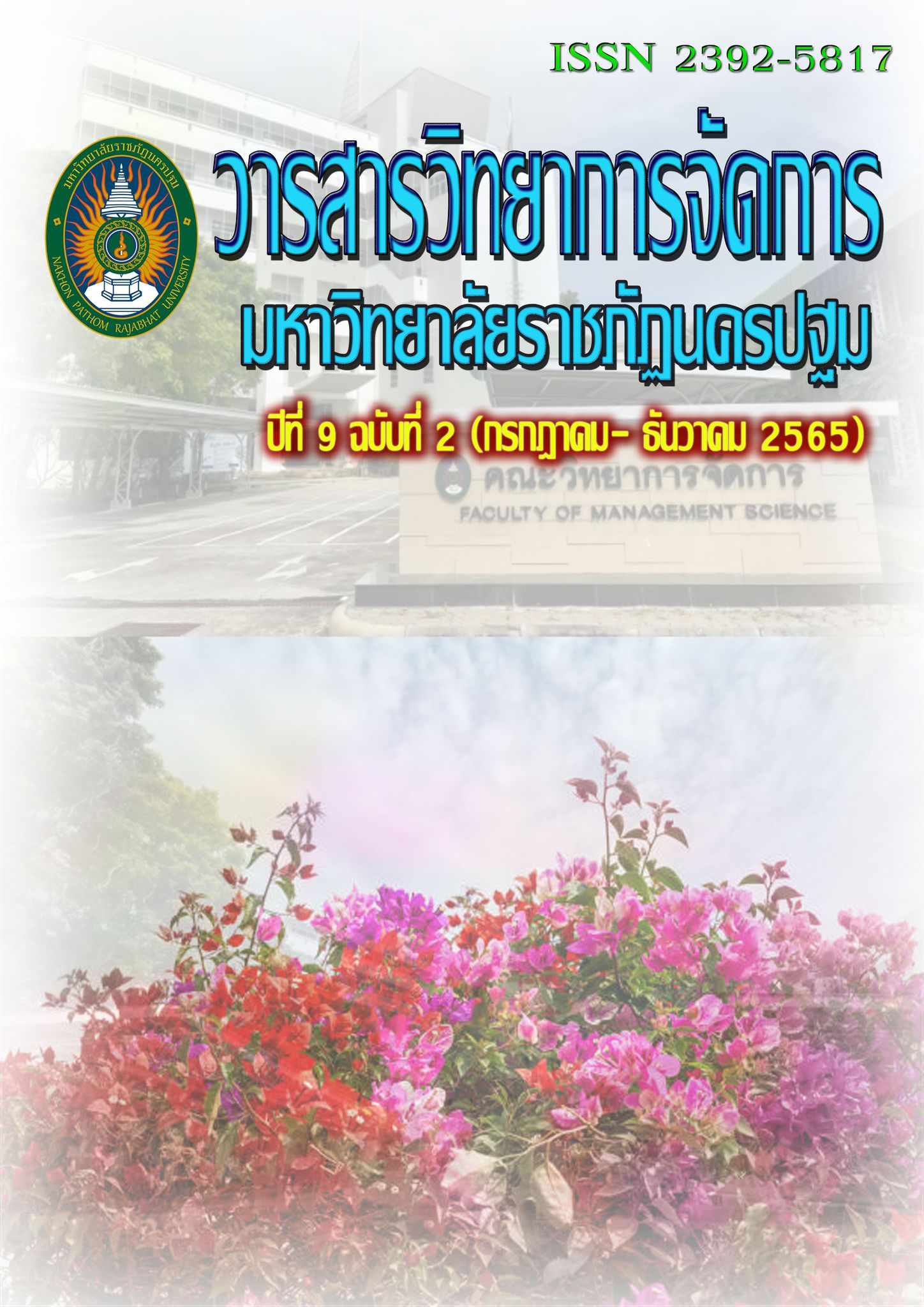ความสัมพันธ์ของปัจจัยเชิงสาเหตุที่มีผลต่อการดำเนินงานธุรกิจเครื่องใช้ไฟฟ้าในเขตกรุงเทพมหานคร และปริมณฑล
Main Article Content
บทคัดย่อ
การวิจัยนี้มีวัตถุประสงค์ (1) เพื่อศึกษาปัจจัยเชิงสาเหตุที่มีผลต่อการดำเนินงานธุรกิจเครื่องใช้ไฟฟ้า ในเขตกรุงเทพมหานคร และปริมณฑล (2) เพื่อศึกษาความสัมพันธ์ของปัจจัยเชิงสาเหตุ ที่มีอิทธิพลต่อการดำเนินงานธุรกิจเครื่องใช้ไฟฟ้า ในเขตกรุงเทพมหานคร และปริมณฑล (3) เพื่อพัฒนารูปแบบความสัมพันธ์ของปัจจัยเชิงสาเหตุที่มีผลต่อการดำเนินงานธุรกิจเครื่องใช้ไฟฟ้า ในเขตกรุงเทพมหานคร และปริมณฑล การวิจัยนี้เป็นการวิจัยแบบผสมผสาน ประกอบด้วยวิจัยเชิงปริมาณและเชิงคุณภาพ โดยผู้วิจัยกำหนดประชากรในการวิจัยครั้งนี้ ได้แก่ ผู้ประกอบการธุรกิจเครื่องใช้ไฟฟ้า ในเขตกรุงเทพมหานคร และปริมณฑล จำนวน 400 คน ซึ่งผู้วิจัยใช้วิธีการสุ่มตัวอย่างแบบหลายขั้นตอน ผู้วิจัยวิเคราะห์ข้อมูลโดยใช้การวิเคราะห์โมเดลสมการโครงสร้าง
ผลการวิจัย พบว่า (1) คุณภาพการบริการ การสื่อสาร การจัดการความขัดแย้ง มีอิทธิพลทางตรงเชิงบวกต่อคุณภาพความสัมพันธ์ระหว่างผู้ซื้อและผู้ขาย และผลการดำเนินงานของธุรกิจเครื่องใช้ไฟฟ้า ได้รับอิทธิพลทางตรงเชิงบวกจากคุณภาพการบริการ การสื่อสาร การจัดการความขัดแย้ง ซึ่งมีความสอดคล้องกับสมมติฐานการวิจัยที่กำหนดไว้ ดัชนีความกลมกลืนของความสัมพันธ์ของปัจจัยเชิงสาเหตุที่มีผลต่อการดำเนินงานธุรกิจเครื่องใช้ไฟฟ้า ในเขตกรุงเทพมหานคร และปริมณฑล โมเดลสอดคล้องกลมกลืนกับข้อมูลเชิงประจักษ์โดยค่าดัชนีความกลมกลืนทั้ง 6 ดัชนีที่ผ่านเกณฑ์ การยอมรับ คือ ค่าดัชนี 2 /df = 1.205, CFI = 1.000, GFI = 0.970, AGFI = 0.960, RMSEA = 0.019 และ SRMR = 0.021 ดังนั้นจึงสรุปได้ว่า โมเดลแบบจําลองสมการเชิงโครงสร้างมีความเหมาะสมกลมกลืนกับข้อมูลเชิงประจักษ์ การปรับโมเดล ผลการวิเคราะห์ค่าดัชนีความกลมกลืนของโมเดล โดยรวมหลังจากที่ผู้วิจัยได้ดำเนินการปรับโมเดล พบว่า โมเดลมีความสอดคล้องกลมกลืนกับข้อมูลเชิงประจักษ์ โดยค่าดัชนีความกลมกลืนที่ผ่านเกณฑ์การยอมรับ คือ ค่าดัชนี 2 = 304.82, df- 160, P-value = 0.000, CFI = 0.990, GFI = 0.950, AGFI = 0.930, RMSEA = 0.040 และSRMR= 0.029 (2) เพื่อให้ผู้ประกอบการธุรกิจเครื่องใช้ไฟฟ้ามีความสัมพันธ์ที่ดีขึ้น ผู้ประกอบการจะต้องนําปัจจัยทางด้านคุณภาพการบริการที่ประกอบด้วย 6 ส่วนด้วยกัน ได้แก่ ความเชื่อมั่น การตอบสนองต่อลูกค้า การให้ความมั่นใจแก่ลูกค้า ความมีประสิทธิภาพ ความเป็นส่วนตัวและการปฏิบัติตามมาใช้ในการบริหารจัดการธุรกิจต่อไป
* หลักสูตรบริหารธุรกิจ มหาวิทยาลัยกรุงเทพธนบุรี กรุงเทพฯ 10170
Corresponding author: sariinya21@hotmail.com
Article Details

อนุญาตภายใต้เงื่อนไข Creative Commons Attribution-NonCommercial-NoDerivatives 4.0 International License.
ทัศนะและข้อคิดเห็นของบทความที่ปรากฏในวารสารฉบับนี้เป็นของผู้เขียนแต่ละท่าน ไม่ถือว่าเป็นทัศนะและความรับผิดชอบของกองบรรณาธิการ
เอกสารอ้างอิง
Caceres, R.C. and Paparoidamis. N.G. (2007). Service quality, relationship satisfaction, trust, commitment and business-to-business loyalty. European of Marketing, 41(7/8) 836-867.
Carr, A.S. and Kaynak, H. (2007). Communication methods, information sharing, supplier development and performance: An empirical study of their relationships. International Journal of Operations and Production Management, 27 (4) 346-370.
Duncan, T. and Moriarty. (1999). Commentary on relationship-based marketing Duncan, communications. Australasian Marketing Journal, 7(1) 118 -20.
Fynes, E. de Bu S. and Marshall, D. (2004). Environmental uncertainty, supply chain relationship quality and performance. Journal of Purchasing and Supply Management, 10. 179-90.
Giovanis, A., Athanasopoulou, P. and Tsoukatos, E. (2015), The role of service fairness in the service quality – relationship quality – customer loyalty chain: An empirical study, Journal of Service Theory and Practice, 25 (6) 744-776. https://doi.org/10.1108/JSTP-11-2013-0263
Gronroos, C. (1984). A Service Quality Model Its Marketing Implications. European Journal of Marketing, 18(4).36-44.
Jessica J. H, David A. G, and Ryan C. W. (2015). Reciprocity in Relationship Marketing: A Cross-Cultural Examination of the Effects of Equivalence and Immediacy on Relationship Quality and Satisfaction with Performance. Journal of International Marketing, 23 (4). 64-83.
Kevin D. Bradford and Barton A. Weitz. (2009). Salespersons' management of conflict in buyer-seller relationships. Journal of Personal Selling and Sales Management, .24(1) 25-42.
Leonidas, C. Leonidou, S. S, Bilge A., and Michael A. T. (2014). Antecedents and Outcomes of Exporter-Importer Relationship Quality: Synthesis, Meta-Analysis, and Directions for Further Research. Journal of International Marketing, 22, (2). 21-46.
Moreira, A.C. and Silva, P.M. (2015). The trust-commitment challenge in service quality-loyalty relationships. International Journal of Health Care Quality Assurance, 28(3). 253-266.
Naoui, F.B and Zaiem,I. (2010). The impact of relationship quality on client's loyalty: An application in the Para pharmaceutical industry. International Journal of Pharmaceutical and Healthcare Marketing, 4 (2) 137-156.
Negi, R. and Ketema.E. (2013). Customer-perceived relationship quality and satisfaction A case of Ethiopian Telecommunication Corporation. African Journal of Economic and Management Studies, 4(1).109-121.
Ozen, H. (2015). Online Relationship Quality: Does It Increase Repurchase Intention from Private Shopping Sites? International Journal of Academic Research in Business and Social Sciences, 5 (7). 300-312.
Parasuraman, A., Zeithaml, V. A., & Berry, L. L. (1985). A conceptual model of service quality and its implications for future research. Journal of marketing, 49(4), 41-50.
Schultz, W., Apicella, P., Scarnati, E., & Ljungberg, T. (1992). Neuronal activity in monkey ventral striatum related to the expectation of reward. Journal of neuroscience, 12(12), 4595-4610.
Sharma, N. and Patterson, P.G. (1999), The impact of communication effectiveness and service quality on relationship commitment in consumer, professional services. Journal of Services Marketing, .13 (2). 151-170. https://doi.org/10.1108/08876049910266059
Thomas, K.W. (1992). Conflict and negotiation processes in organizations. In Handbook of industrial and organizational psychology, Marvin D. Dunnette, ed. (2nd ed.), Vol. 3. Palo Alto, CA: Consulting Psychologists Press, 651-717.


